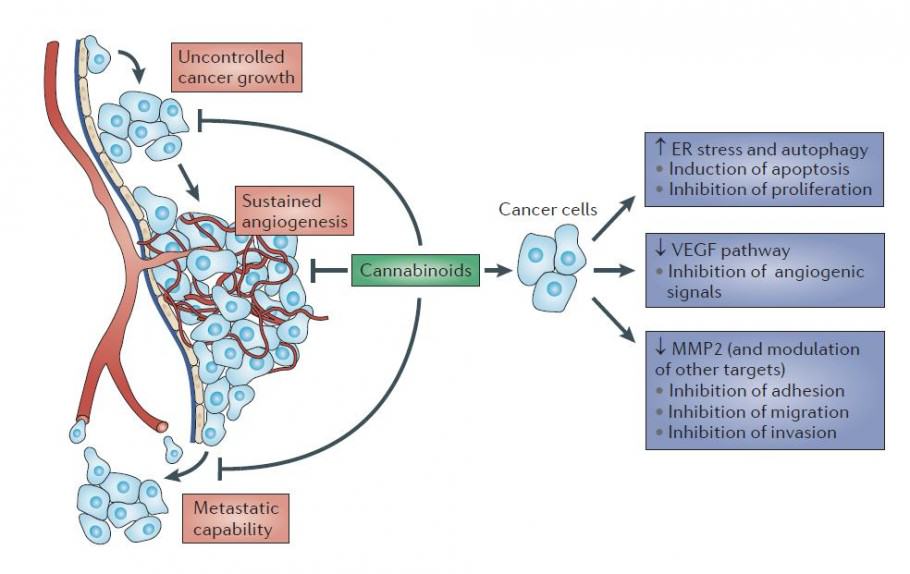
Cannabis has a profound influence on the human body. This one herb and its variety of therapeutic compounds seem to affect every aspect of our bodies and minds. How is this possible? At integrative medical clinics in the US states of Maine and Massachusetts, over 18,000 patients with a huge diversity of diseases and symptoms are being treated. In one day patients present with cancer, Crohn's Disease, epilepsy, chronic pain, Multiple Sclerosis, insomnia, Tourette's Syndrome and eczema, just to name a few. All of these conditions have different causes, different physiologic states and vastly different symptoms. The patients are old and young. Some are undergoing conventional therapy, others are on a decidedly alternative path, yet despite their differences, almost all patients would agree on one point: cannabis helps their condition.
Physicians are naturally wary of any medicine that purports to cure-all. Panaceas, snake-oil remedies and expensive fads often come and go, with big claims but little scientific or clinical evidence to support their efficacy. Exploring the therapeutic potential of cannabis, however, we find no lack of evidence. In fact, an explosion of scientific research on the therapeutic potential of cannabis, more evidence than one can find on some of the most widely used therapies of conventional medicine exists.
A PubMed search in 2015 for scientific journal articles published in the last 20 years containing the word 'cannabis' reveals over eight-and-a-half thousand results. Add the word 'cannabinoid' and the results increase to over twenty-one thousand articles. That's an average of more than two scientific publications per day over the last 20 years! These numbers not only illustrate the present scientific interest and financial investment in understanding more about cannabis and its components, but they also emphasise the need for high quality reviews and summaries (not more 'reefer madness' as is currently being regurgitated [even though debunked by international academics and health professionals such as The International Centre for Science in Drug Policy, ICSDP] among academia and public health in Australia).

How can one herb help so many different conditions? How can it provide both palliative and curative actions? How can it be so safe while offering such powerful effects? The search to answer these questions has led scientists to the discovery of a previously unknown physiologic system, a central component of the health and healing of every human and almost every animal: the Endogenous Cannabinoid System.
The Endogenous Cannabinoid System (ECS), named after the plant that led to its discovery, is perhaps the most important physiologic system involved in establishing and maintaining human health. Endocannabinoids and their receptors are found throughout the body: in the brain, organs, connective tissues, glands, and immune cells. In each tissue, the cannabinoid system performs different tasks, but the goal is always the same: homoeostasis, the maintenance of a stable internal environment despite fluctuations in the external environment.
Cannabinoids promote homoeostasis at every level of biological life, from the sub-cellular to the organism and perhaps to the community and beyond. Here's one example: autophagy, a process in which a cell sequesters part of its contents to be self-digested and recycled, is mediated by the cannabinoid system. While this process keeps normal cells alive, allowing them to maintain a balance between the synthesis, degradation and subsequent recycling of cellular products, it has a deadly effect on malignant tumour cells, causing them to consume themselves in a programmed cellular suicide. The death of cancer cells, of course, promotes homoeostasis and survival at the level of the entire organism.
 |
| Efficiency of cannabinoids against cancer |
Endocannabinoids and cannabinoids are also found at the intersection of the body's various systems, allowing communication and coordination between different cell types. At the site of an injury, for example, cannabinoids can be found decreasing the release of activators and sensitisers from the injured tissue, stabilising the nerve cell to prevent excessive firing, and calming nearby immune cells to prevent release of pro-inflammatory substances. Three different mechanisms of action on three different cell types for a single purpose: minimise the pain and damage caused by the injury.
The ECS, with its complex actions in our immune system, nervous system, and all of the body's organs, is literally a bridge between body and mind. By understanding this system we begin to see a mechanism that explains how states of consciousness can promote health or disease.
In addition to regulating our internal and cellular homoeostasis, cannabinoids influence a person's relationship with the external environment. Socially, the administration of cannabinoids clearly alters human behaviour, often promoting sharing, humour and creativity. By mediating neurogenesis (process by which new nerve cells are generated), neuronal plasticity and learning, cannabinoids may directly influence a person's open-mindedness and ability to move beyond limiting patterns of thought and behaviour from past situations. Reformatting these old patterns is an essential part of health in our quickly changing environment.
Sea squirts, tiny nematodes and all vertebrate species share the ECS as an essential part of life and adaptation to environmental changes. By comparing the genetics of cannabinoid receptors in different species, scientists estimate that the ECS evolved in primitive animals over 600 million years ago.
While it may seem we know a lot about cannabinoids, the estimated twenty thousand scientific articles have just begun to shed light on the subject. Large gaps likely exist in our current understanding and the complexity of interactions between various cannabinoids, cell types, systems and individual organisms challenge scientists to think about physiology and health in new ways. The following brief overview summarises what is known.
Cannabinoid receptors are present throughout the body, embedded in cell membranes and are believed to be more numerous than any other receptor system. When cannabinoid receptors are stimulated, a variety of physiologic processes ensue. Researchers have identified two cannabinoid receptors: CB1, predominantly present in the nervous system, connective tissues, gonads, glands, and organs; and CB2, predominantly found in the immune system and its associated structures. Many tissues contain both CB1 and CB2 receptors, each linked to a different action. Researchers speculate there may be a third cannabinoid receptor waiting to be discovered.
 |
| A neurotransmitter called anandamide was isolated in chocolate by neuroscientist Daniel Piomelli in 1996 |
Endocannabinoids are the substances our bodies naturally make to stimulate these receptors. The two most well understood of these molecules are called anandamide and 2-arachidonoylglycerol (2-AG). They are synthesised on-demand from cell membrane arachidonic acid derivatives (important family of regulatory molecules), have a local effect and short half-life before being degraded.
 Phytocannabinoids are plant substances that stimulate cannabinoid receptors. Delta-9-tetrahydrocannabinol, or THC, is the most psychoactive and certainly the most famous of these substances, but other cannabinoids such as cannabidiol (CBD) and cannabinol (CBN) are gaining the interest of researchers due to a variety of healing properties. Most phytocannabinoids have been isolated from Cannabis sativa L., but other medical herbs, such as Echinacea purpura, have been found to contain non-psychoactive cannabinoids as well.
Phytocannabinoids are plant substances that stimulate cannabinoid receptors. Delta-9-tetrahydrocannabinol, or THC, is the most psychoactive and certainly the most famous of these substances, but other cannabinoids such as cannabidiol (CBD) and cannabinol (CBN) are gaining the interest of researchers due to a variety of healing properties. Most phytocannabinoids have been isolated from Cannabis sativa L., but other medical herbs, such as Echinacea purpura, have been found to contain non-psychoactive cannabinoids as well.
Interestingly, the cannabis plant also uses THC and other cannabinoids to promote its own health and prevent disease. Cannabinoids have antioxidant properties that protect the leaves and flowering structures from ultraviolet radiation - cannabinoids neutralise the harmful free radicals generated by UV rays, protecting the cells. In humans, free radicals cause ageing, cancer, and impaired healing. Antioxidants found in plants have long been promoted as natural supplements to prevent free radical harm.
Laboratories can also produce cannabinoids. Synthetic THC, marketed as dronabinol (Marinol), and nabilone (Cesamet), a THC analogue, are both US FDA approved drugs for the treatment of severe nausea and wasting syndrome. Some clinicians have found them helpful in the off-label treatment of chronic pain, migraine and other serious conditions. Many other synthetic cannabinoids are used in animal research, and some have potency up to 600 times that of THC (and all are second-rate in comparison to whole, organic cannabis).
As we continue to sort through the emerging science of cannabis and cannabinoids, one thing remains clear: a functional cannabinoid system is essential for health. From embryonic implantation on the wall of our mother's uterus, to nursing and growth, to responding to injuries, endocannabinoids help us survive in a quickly changing and increasingly hostile environment.
Research has shown that small doses of cannabinoids from cannabis can signal the body to make more endocannabinoids and build more cannabinoid receptors. This is why many first-time cannabis users don't feel an effect, but by their second or third time using the herb they have built more cannabinoid receptors and are ready to respond. More receptors increase a person's sensitivity to cannabinoids; smaller doses have larger effects, and the individual has an enhanced baseline of endocannabinoid activity. Small, regular doses of cannabis might act as a tonic to our most central physiologic healing system.
Many physicians cringe at the thought of recommending a botanical substance and are outright mortified by the idea of smoking a medicine. Our medical system is more comfortable with single, isolated substances that can be swallowed or injected. Unfortunately, this model significantly limits the therapeutic potential of cannabinoids.
Unlike synthetic derivatives, herbal cannabis may contain over one hundred different cannabinoids, including THC, which all work synergistically to produce better medical effects and less side effects than THC alone. While cannabis is safe and works well when smoked, many patients prefer to avoid respiratory irritation and instead use a vaporiser, cannabis tincture or topical salve. Scientific inquiry and patient testimonials both indicate that herbal cannabis has superior medical qualities to synthetic cannabinoids.
In 1902 Thomas Edison said, "There were never so many able, active minds at work on the problems of disease as now and all their discoveries are tending toward the simple truth that you can't improve on nature." Cannabinoid research has proven this statement is still valid.
 |
| Ancient Tibetan medicine |
So, is it possible that medical cannabis could be the most useful remedy to treat the widest variety of human diseases and conditions, a component of preventative healthcare, and an adaptive support in our increasingly toxic, carcinogenic environment? Yes. This was well known to the indigenous medical systems of ancient India, China and Tibet, and is becoming increasingly well known by western science. Of course, we need more human-based research studying the effectiveness of cannabis, but the evidence base is already large and growing constantly, despite the US DEA's (and many other jurisdictions) best efforts to discourage cannabis-related research.






No comments:
Post a Comment